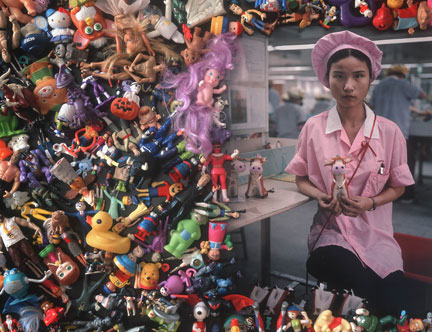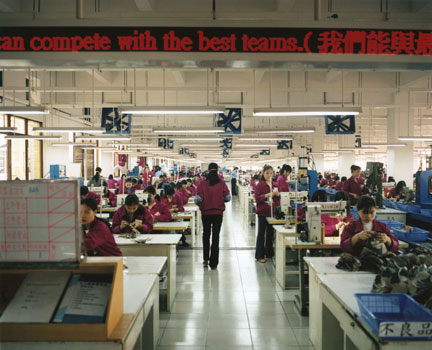Made in China

About the Exhibition
Made in China
Work by:
Edward Burtynsky
Polly Braden
Melanie Jackson
Michael Wolf
Danwen Xing
Jun Yang
John Schmid and Rick Romell
In 1803 Napoleon Bonaparte surveyed a map and pointed to China saying “China is a sickly, sleeping giant. But when she awakes the world will tremble.”1 Two centuries later, China is wide awake and has become a dominant force in the global market. China however, had not always been asleep, for its ancient name alone translates to “Middle Kingdom,” referring to the supposed position of China at the center of the known world. For millennia China was arguably one of the strongest and richest empires in the world in technology, literature, and art – so much so that its rulers saw little value in contacting anyone else in the world. Building the Great Wall of China in 1368-1644 and encircling 3,946 miles of their land could not be a bigger symbol for this closure. This relative isolation lasted until the early 19th century when Western nations started to demand free trade with China. The Opium War (1839-1842), after which China was forced to sign the first of several “unequal treaties” with the British conquerors, opened China to Western merchants and foreign-ruled enclaves. In 1894 the Japanese joined the Western race for commercial access to China and through World War II occupied much of the country, with now well known disastrous consequences. At the end of WWII, American forces backed out of China and, in 1949, Chairman Mao Zedong proclaimed the establishment of the People’s Republic of China leading to decades of failed communist rule and closed foreign trade, leading ultimately to economic and social crisis.
It was not until President Nixon’s 1972 visit to China that a new trade relationship was begun between the U.S. and China. The Chinese leadership moved away from central planning to a more regional and market-oriented economy, and focused on foreign trade as a major vehicle for economic growth. The result has been that in a quarter of a century, China has transformed itself from an impoverished and closed agricultural society to a globally integrated industrial powerhouse. With low-cost manufacturing, non-unionized abundant cheap labor, and free trade agreements, more companies from Western countries are moving production to China. Chinese factories turn out 38% of the world’s mobile phones, half the world’s cameras and half of its shoes.
The exhibition aims to humanize this world-shaking development, and to put a face on the “Made in China” label.
This exhibition, Made in China, explores the dense layers of cultural messages, media impressions, and material products emanating from China, and through a series of subtle juxtapositions, visits the possibility that history’s oldest civilization might again become the Middle Kingdom, a major center of world economy. The exhibition aims to humanize this world-shaking development, and to put a face on the “Made in China” label.
The massive scale of the transformation that has taken place in China is visualized in Edward Burtynsky’s (Canada, b. 1955) recent photographs of enormous factories employing thousands of workers in newly established zones of Chinese industrialization, offering rare access to the sheer enormity of the industry. This ominous yet eerily seductive examination is achieved by Burtynsky’s distant and formal approach. By using a large-format camera and filling the frame with rows and rows of production lines, the factories and the workers become almost infinite. However in some pictures, particularly one in a large cafeteria, an individual stands out alone, wearing bright color, against rows of machines. It is at this point that one recognizes that there is a personal story behind each of the millions of factory workers.
The photography of Polly Braden (United Kingdom, b. 1974) documents one individual’s story within this massive social change. Braden follows Ho Ping, a young girl from the Henan Province, to work for Selena, a shoe factory that produces products for Nine West and Clarks, amongst others. Braden documents Ho Ping and her 6,500 co-workers, all of whom live at the factory in tight quarters, often operating under strict rules. Concerned less with Ho Ping’s exploitation, Braden focuses on the material prosperity she enjoys. Like thousands of others, factory work has brought her out of poverty and turned her into a consumer— in one picture, Ho Ping shops for shoes with her friends in a mall. Braden then follows Ho Ping home to visit her village where she documents her showing pictures of her new life stored in her cell phone to her family and friends, who still live in an agricultural society that has changed little since the 18th century.
Like thousands of others, factory work has brought her out of poverty and turned her into a consumer— in one picture, Ho Ping shops for shoes with her friends in a mall.
Melanie Jackson’s (United Kingdom, b. 1968) multi-video installation weaves together the tales of two Chinese women who uproot themselves from their rural family villages to experience urbanization, migration and ultimately alienation. One, a musician, migrates from her village to London to study the erhu, a traditional Chinese stringed instrument. Jackson films her tedious, demanding rehearsals, culminating in a short six-minute recital that symbolizes her internal freedom. But she ultimately succumbs to alienation as she discovers her Chinese roots and culture, unexpectedly, while living in a foreign land. Meanwhile, the other young woman’s story unfolds in a silent animated video that takes us on her troubled journey from home to work in an eyelash factory to earn money to support her family. We see her first in her bedroom daydreaming of economic and social freedoms as she looks at contemporary fashion magazines and posters of Shanghai on her wall. We then follow her into the factory where she makes 400 eyelashes per month using 450 one-inch pieces of hair. Ultimately, due to harsh treatment and unbearable living conditions in the factory, she quits and finds herself alone, far away from home.
…Wolf seeks to capture the idiosyncratic environment of the factories and the rich individuality of those employed to hand produce an unending stream of identical toys.
Michael Wolf (Germany, b. 1954; resides in Hong Kong) provides yet another view from a different angle of factory workers and the ubiquity of their output through an installation of thousands of used toys bought in flea markets in California and installed with photographic portraits of workers in southern Chinese toy factories where they were all made. The toys potentially awaken specific childhood memories for people when surrounded by the mass installation, as they think about their own early introduction to, and role in, consumer culture. While the photographs surrounded by the toys engage the concept of working conditions in Chinese toy factories, they do not indict the conditions. Rather Wolf seeks to capture the idiosyncratic environment of the factories and the rich individuality of those employed to hand produce an unending stream of identical toys.
Danwen Xing’s (China, b. 1967) photographs of piles of electronic trash offer a perspective on the reverse flow of consumable objects made in China, specifically the reimportation of recyclable used materials. Every day thousands of containers full of obsolete computers, telephones, and stereos from Japan, South Korea, and the United States arrive along the coast of China’s Guangdong Province where more than 100,000 workers make their living by recycling. Circuit boards are smelted to extract trace amounts of gold; an average computer monitor can yield as much as eight pounds of lead. The tangled wires, plastic cases, and broken cell phones portrayed in Xing’s pictures reflect raw economics at work in China, although their strange repetitive beauty places these objects in suggestive tension with their social context.
Similar to Melanie Jackson’s musician studying her cultural roots in the West, artist Jun Yang (China, b. 1975; Austrian citizen) left China with his family in 1979 to live in Vienna, Austria. In HERO -this is WE, included at the 2005 Venice Bienniale, Yang explores China’s political and economic development by showing the extent to which it is mirrored in the international presence of its national flag. In 1984 China won its first and only gold medal at the Olympic Games, but twenty years later China is among the top winners of gold medals, and hence its flag dominates the scenes of cheering crowds at The Games. Yang also leads us through stories about heroes, including for example Yao Ming, the Chinese NBA basketball player in the USA, a super-sport-star who has now altered the cliché perpetuated by the media of the Chinese as small supernatural warriors à la Bruce Lee.HERO – this is WE follows a nation’s identity change-China now manifests its identity as a self-confident superpower, with authentic heroes, prominent in the media in the omnipresence of the national flag.
Finally, Made in China takes a look at how we must include price deflation among key Chinese exports: Costs to U.S. producers and consumers are drastically reduced by new industrialization in China. The cost of dismantling and reusing recycled materials in the U.S. is about 10 times as high as the cost of shipping the materials to China. A similar ratio holds true when Western companies move their manufacturing plants to China. At the end of 2003 reporters John Schmid (United States, b. 1961), Rick Romell (United States, b. 1950) and photojournalist Gary Porter (United States, b. 1950) published an in-depth series titled Made in China: The New Industrial Revolution for the Milwaukee Journal Sentinel. Their efforts won the prestigious 2003 National Headliner Award, the 2004 Award for Excellence in Economic Reporting, The Associated Press’ 2004 International Perspective Award, and the Inland Press Association’s top award for Explanatory Reporting. This series investigates how Wisconsin’s economy has been reshaped by China’s manufacturing power and the resulting profound effect on Wisconsin communities. The series begins with a story of how Wisconsin kitchen appliance manufacturer Nesco, well known for its humble all-American roaster, was compelled to close its factories in Algoma and Two Rivers in 2000 owing to Chinese competition. It then profiles the factory and the workers in China who now manufacture the roaster under the Nesco brand name for the US market — at half the price, by paying entry-level employees 27 cents an hour plus room and board, a cost obviously impossible to match in Wisconsin.
The 18th and 19th century Industrial revolution – which inspired isolationist tendencies among Chinese authorities fearful of the social repercussions of a mass migration from rural to urban – has now made a complete invasion. A consequence of this process has been that manufacturing firms that have been at the heart of economic and social life in small Amertican cities for several generations are now moving production overseas, raising equally profound questions about social outcomes. Photographic newspaper reportage, as seen in the stellar Milwaukee Journal Sentinel piece, is particularly well suited for examining the advantages and disadvantages of these phenomena. This exhibition also acknowledges that artistic views extend our understanding of the human consequences involved: global for one set of people is local for another. Through metaphor, personal narration, and, in some cases, abstraction, the artists seen here communicate by indirection in addition to the direct facts of reportage, widening our understanding of what globalization really means.
-Natasha Egan, Associate Director
1 Attributed to Napoleon by Lord Amherst, from Safire’s New Political Dictionary by William Safire (Random House, New York, 1993).
Made in China has been co-presented by the Goethe-Institut Chicago. The exhibitions, presentations, and related programs of the MoCP are sponsored in part by U.S. Bank; the Illinois Arts Council, a state agency; The Mayer and Morris Kaplan Family Foundation; The Henrietta Lange Burk Fund; The Palmer Foundation; the City of Chicago Department of Cultural Affairs/After School Matters; the Consulate General of the Peoples’ Republic of China; and American Airlines, the official airlines of the MoCP, and our members.






Image Gallery

